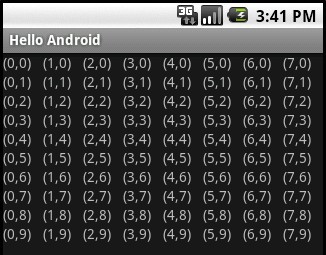
- Android 读取Properties配置文件的小例子
- Android实现文字和图片混排(文字环绕图片)效果
- Android ListView详解
- Android一次性退出多个Activity的方法
- Android游戏开发 自定义手势--输入法手势技术
- Android编程获取屏幕宽高与获取控件宽高的方法
- Android编程实现popupwindow弹出后屏幕背景变成半透明效果
- android WebView加载html5介绍
- Android获取本机电话号码的简单方法
- Android中Service服务详解(二)
- 汇总Android视频录制中常见问题
- Android快速分析apk工具aapt的使用教程
- Android播放视频的三种方式
- Android AbsoluteLayout和RelativeLayout布局详解
- 几个Android编程时需要注意的 web 问题
- android横竖屏切换时候Activity的生命周期
- Android WebView组件用法详解
- Android解析Intent Filter的方法
- Android 将 android view 的位置设为右下角的解决方法
- Android性能优化以及数据优化方法
- Android编程实现设置按钮背景透明与半透明及图片背景透明的方法
- Android编程之数据库Sql编程实例分析
- Android利用悬浮按钮实现翻页效果
- android开发教程之startActivityForResult使用方法
- Android编程之控件状态配置文件实例
- android闹铃简单实现
- Android中XUtils3框架使用方法详解(一)
- 配置一个好用的Android模拟器让你不再对模拟器那么失望
- android中实现指针滑动的动态效果方法
- Android开发笔记之:用Enum(枚举类型)取代整数集的应用详解
Android入门之TableLayout应用解析(二)
作者:佚名 Android开发编辑:admin 更新时间:2022-07-23
本文在上一篇初步介绍TableLayout常用属性的基础上,将进一步介绍如何UI设计器设计TableLayout + TableRow。由于实际应用中,经常需要在代码里往TableLayout添加数据(9宫图也可以用TableLayout做出来 ),本文就是介绍这方面的简单使用方法。
main.xml的代码如下,用到TableLayout的ID为TableLayout01:
<?xml version="1.0" encoding="utf-8"?>
<LinearLayout xmlns:android="http://schemas.android.com/apk/res/android"
android:orientation="vertical"
android:layout_width="fill_parent"
android:layout_height="fill_parent"
>
<TableLayout
android:id="@+id/TableLayout01"
android:layout_width="fill_parent"
android:layout_height="wrap_content">
</TableLayout>
</LinearLayout>
JAVA代码部分如下:
package com.LayoutDemo;
import com.LayoutDemo.R;
import android.app.Activity;
import android.os.Bundle;
import android.view.ViewGroup;
import android.widget.TableLayout;
import android.widget.TableRow;
import android.widget.TextView;
public class LayoutDemo extends Activity {
/** Called when the activity is first created. */
private final int WC = ViewGroup.LayoutParams.WRAP_CONTENT;
private final int FP = ViewGroup.LayoutParams.FILL_PARENT;
@Override
public void onCreate(Bundle savedInstanceState) {
super.onCreate(savedInstanceState);
setContentView(R.layout.main);
//新建TableLayout01的实例
TableLayout tableLayout = (TableLayout)findViewById(R.id.TableLayout01);
//全部列自动填充空白处
tableLayout.setStretchAllColumns(true);
//生成10行,8列的表格
for(int row=0;row<10;row++)
{
TableRow tableRow=new TableRow(this);
for(int col=0;col<8;col++)
{
//tv用于显示
TextView tv=new TextView(this);
tv.setText("("+col+","+row+")");
tableRow.addView(tv);
}
//新建的TableRow添加到TableLayout
tableLayout.addView(tableRow, new TableLayout.LayoutParams(FP, WC));
}
}
}
结果如下图:

- 上一篇文章: Android入门之ListView应用解析(一)
- 下一篇文章: Android入门之TableLayout应用解析(一)
- Android内存泄漏终极解决篇(下)
- Android开发小技巧篇之集合
- 详解Android开发中Activity的四种launchMod
- Android中ViewFlipper的使用及设置动画效果
- android防止提交事件时触发多个表单中的按钮
- 超酷炫的Android碎纸机效果推荐
- Android中的脑残设计总结